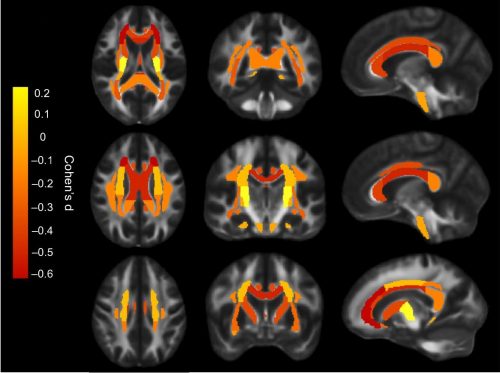
Psychiatric disorders are usually diagnosed by observations of clinical symptoms over time. These symptoms may be specific to a particular psychiatric disorder, or common across one or more other disorders. Could disease-unique and common symptoms be explained by measurable biological markers such as cognitive function, neurophysiology, and neuroimaging? In a new study published in the journal Molecular Psychiatry by the COCORO consortium composed of senior author Ryota Hashimoto of the National Center of Neurology and Psychiatry in Tokyo, Japan, lead author Daisuke Koshiyama of the University of Tokyo School of Medicine, and participating Japanese and international medical research institutions including the International Research Center for Neurointelligence (IRCN) at the University of Tokyo, diffusion tensor imaging (DTI) revealed complex patterns of microscopic changes in the brain’s white matter across four major psychiatric disorders: schizophrenia, bipolar disorder, major depression, and autism spectrum disorder. Mega-analyses indicated similarities between schizophrenia and bipolar disorder in the limbic system that facilitates processing of memory and emotion, while autism spectrum disorder also shared abnormalities in the interhemispheric bundle of the corpus callosum. In another grouping, major depression and autism spectrum disorder shared a relative lack of microstructural defects suggesting other causes of etiology. Schizophrenia was unique in having defects in discrete neocortical tracks. Together the results reveal that each psychiatric disorder has a unique fingerprint of white matter microstructural abnormalities that may provide clues to understand the commonalities and differences in symptoms. Those novel findings should encourage future neuroclinical investigations into the pathophysiology of psychiatric disorders.
Correspondent: Charles Yokoyama, Ph.D., IRCN Science Writing Core
Acknowledgment: The authors would like to thank all the participants in the current study. This research was supported by the program for Brain/MINDS & beyond studies (Grant Number JP19dm0307002, JP19dm0307001, JP19dm0307004), Brain Mapping by Integrated Neurotechnologies for Disease Studies (Brain/MINDS; Grant Number JP18dm0207006, 19dm0207069) from the Japan Agency for Medical Research and Development (AMED), and Grants-in-Aid for Scientific Research from the Ministry of Education, Culture, Sports, Science and Technology-Japan (MEXT)
Reference: Koshiyama D, Fukunaga M, Okada N, Morita K, Nemoto K, Usui K, Yamamori H, Yasuda Y, Fujimoto M, Kudo N, Azechi H, Watanabe Y, Hashimoto N, Narita H, Kusumi I, Ohi K, Shimada T, Kataoka Y, Yamamoto M, Ozaki N, Okada G, Okamoto Y, Harada K, Matsuo K, Yamasue H, Abe O, Hashimoto R, Takahashi T, Hori T, Nakataki M, Onitsuka T, Holleran L, Jahanshad N, van Erp TG, Turner JA, Donohoe G, Thompson PM, Kasai K, Hashimoto R, COCORO (2019) White matter microstructural alterations across four major psychiatric disorders: mega-analysis study in 2937 individuals. Molecular Psychiatry. Published online: November 29th , 2019. DOI: 10.1038/s41380-019-0553-7,
URL: https://www.nature.com/articles/s41380-019-0553-7
Media Contact: The author is available for interviews in English.
Ryota Hashimoto M.D., Ph.D.
Director of Department of Pathology of Mental Diseases,
National Institute of Mental Health, National Center of Neurology and Psychiatry (NCNP)
Email: ryotahashimoto55@ncnp.go.jp
Naohiro Okada, M.D., Ph. D., Project Associate Professor
Kiyoto Kasai, M.D., Ph.D., Professor
International Research Center for Neurointelligence
Department of Neuropsychiatry, Graduate School of Medicine
The University of Tokyo
Email: nokada-tky@umin.ac.jp; kasaik-tky@umin.net
Mayuki Satake
Public Relations
International Research Center for Neurointelligence
The University of Tokyo
Email: pr@ircn.jp


